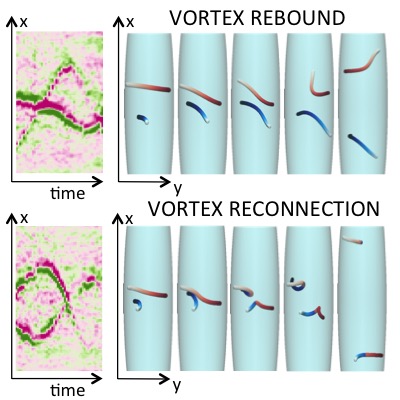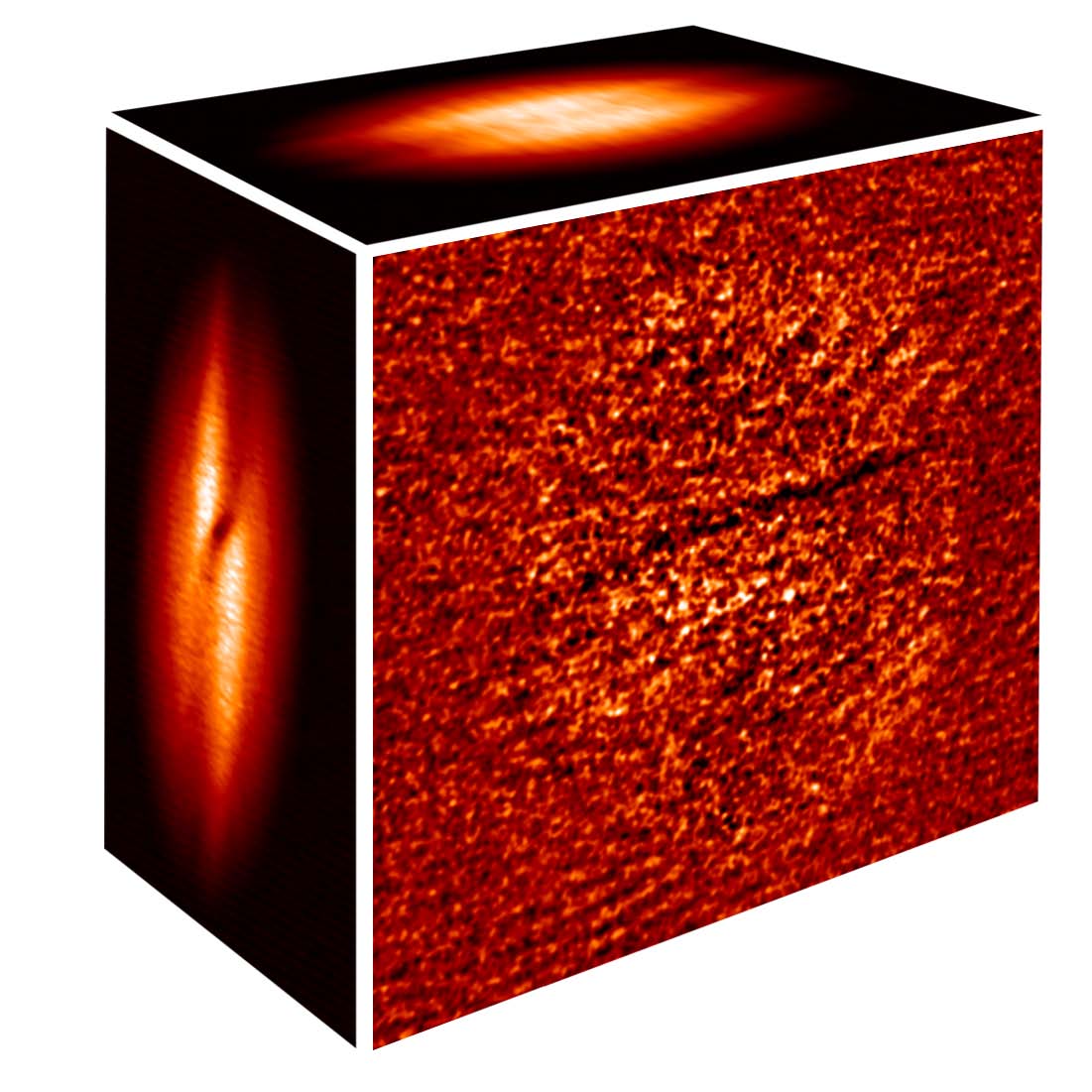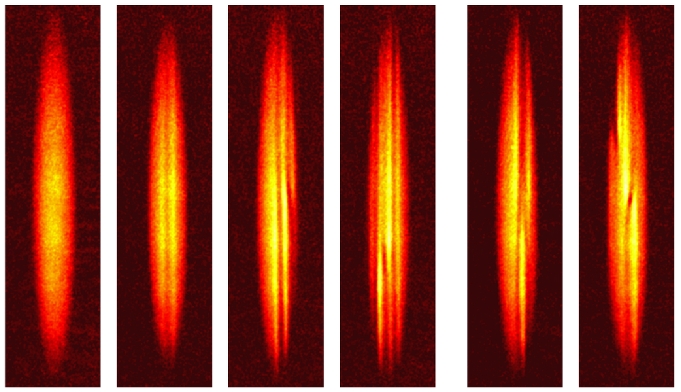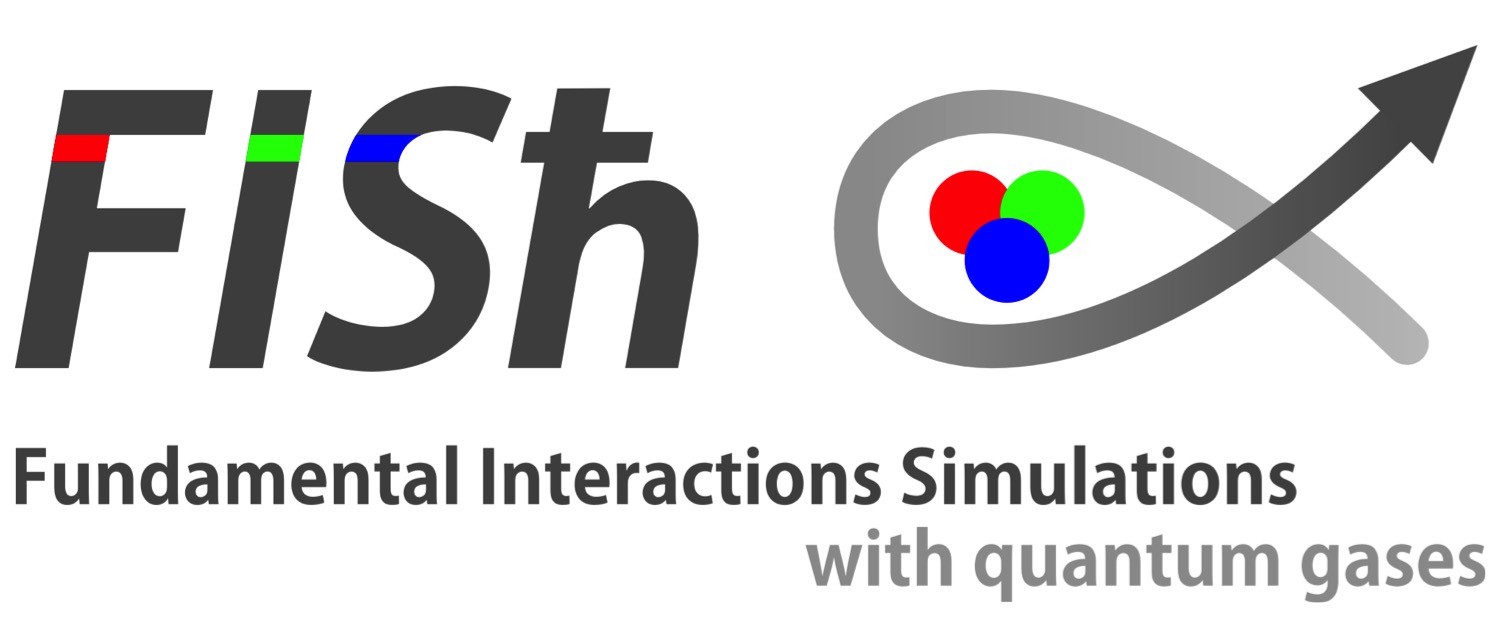[ Experiments ]
[ Theory of quantum gases ]
[ Fluids of light ]
[ Quantum information ]
Experiments with ultracold atoms
Principal investigators:
Gabriele Ferrari,
Giacomo Lamporesi,
Alessandro Zenesini.
Postdocs:
Dimitrios Trypogeorgos,
Carmelo Mordini.
PhD students:
Arturo Farolfi,
Louise Wolswijk.
Main research field:
- VORTEX PHYSICS IN SUPERFLUIDS
- TWO-COMPONENT CONDENSATES
- COOLING TECHNIQUES
Recent PhD theses:
WORK WITH US: Students are welcome to join us and work in the lab on any of the ongoing research activities
VORTEX PHYSICS IN SUPERFLUIDS
Vortex-vortex interaction mechanisms
Axially symmetric elongated traps allow transverse vortices to approach with random relative velocity and orientation, differently from what happens in flat traps or in rotating condensates. We observe in real time the vortex filament orientation and position in the condensate and study different interaction mechanisms that occur depending on their approaching velocities and relative orientation.
Reference:
Vortex Reconnections and Rebounds in Trapped Atomic Bose-Einstein Condensates
S. Serafini, L. Galantucci, E. Iseni, T. Bienaimé, R.N. Bisset, C.F. Barenghi, F. Dalfovo, G. Lamporesi and G. Ferrari
arXiv:1611.01691,
Phys. Rev. X 7, 021031 (2017)
|

Two orthogonal vortices approach and may bounce without touching (if their relative velocity is small enough) or touch and reconnect exchanging their tails (for large relative velocities).
|
Vortex dynamics in cigar-shaped BECs
Single vortices in elongated condensates are mainly oriented along a radial direction and tend to move on elliptical orbits around the center. We track their dynamics by performing a real-time weakly destructive imaging. The measured period verifies the predicted dependence on the local chemical potential. Whenever vortices do not lie on a radial plane but are slightly tilted, they experience a torque that forces them to precess around the long symmetry axis of the trap to conserve the angular momentum along such axis.
References:
Dynamics and Interaction of Vortex Lines in an Elongated Bose-Einstein Condensate
S. Serafini, M. Barbiero, M. Debortoli, S. Donadello, F. Larcher, F. Dalfovo, G. Lamporesi and G. Ferrari
arXiv:1507.01511,
Phys. Rev. Lett. 115, 170402 (2015)
Observation of a Spinning Top in a Bose-Einstein Condensate
R.N. Bisset, S. Serafini, E. Iseni, M. Barbiero, T. Bienaimé, G. Lamporesi, G. Ferrari and F. Dalfovo
arXiv:1705.09102,
Phys. Rev. A 96, 053605 (2017)
(see also Synopsis in Physics)
|
 Tilted vortices orbiting around the trap center and spinning about the trap axis.
Tilted vortices orbiting around the trap center and spinning about the trap axis.
|
Solitonic vortices
The geometrical properties of a system have an influence on the
nature of defects that can be supported. Besides common solitons in
quasi 1D systems and vortices in round pancake like condensates, we
observed solitonic vortices in elongated samples. These hybrid defects
are vortices aligned along a short axis with a 2pi phase winding, but
also show a planar density depletion in the radial plane containing
the vortex.
References:
Observation of Solitonic Vortices in Bose-Einstein Condensates
S. Donadello, S. Serafini, M. Tylutki, L.P. Pitaevskii, F. Dalfovo, G. Lamporesi and G. Ferrari
arXiv:1404.4237,
Phys. Rev. Lett. 113, 065302 (2014)
(see also Physics Viewpoint)
Solitonic Vortices in Bose-Einstein Condensates
M. Tylutki, S. Donadello, S. Serafini, L.P. Pitaevskii, F. Dalfovo, G. Lamporesi and G. Ferrari
arXiv:1410.5475,
Eur. Phys. J. Special Topics 224, 473-475 (2015)
Optical visibility and core structure of vortex filaments in a bosonic superfluid
F. Dalfovo, R.N. Bisset, C. Mordini, G. Lamporesi, G. Ferrari
arXiv:1804.03017,
J. Exp. Theor. Phys. 127, 804 (2018)
|
 
Tri-axial absorption imaging of elongated BECs after a long
time of flight providing clear signatures of the presence of
solitonic vortices with opposite circulation.
|
Spontaneous generation of defects
Quantum criticalities are mechanisms driving disparate phenomena ranging
from the origin of our universe to the appearance of defects in uniform
systems. We use ultracold atoms at the BEC transition to explore the
Kibble-Zurek mechanism by directly observing the creation of phase
defects in the order parameter of a Bose-Einstein condensate for temperature
quenched BECs of sodium atoms.
References:
Spontaneous creation of Kibble-Zurek solitons in a Bose-Einstein condensate
G. Lamporesi, S. Donadello, S. Serafini, F. Dalfovo and G. Ferrari
arXiv:1306.4523,
Nat. Phys. 9, 656 (2013)
Creation and counting of defects in a temperature-quenched Bose-Einstein condensate
S. Donadello, S. Serafini, T. Bienaimé, F. Dalfovo, G. Lamporesi, and G. Ferrari
arXiv:1605.02982,
Phys. Rev. A 94, 023628 (2016)
Dynamical equilibration across a quenched phase transition in a trapped quantum gas
I.-K. Liu, S. Donadello, G. Lamporesi, G. Ferrari, S.-C. Gou, F. Dalfovo, N.P. Proukakis
arXiv:1712.08074,
Commun. Phys. 1, 24 (2018)
|

A condensate of Sodium atoms is formed by quenching the temperature
across the BEC phase transition. If the quench is fast, defects appear in the
order parameter due to the Kibble-Zurek mechanism.
|
TWO-COMPONENT CONDENSATES
Quantum simulation of quark confinement
A slowly rotating binary BEC might have a vortex in each component that orbits around the trap center.
In presence of a coherent coupling, the two vortices lock at a precise distance given by the intercomponent interaction strength.
The force between such vortices is strongly analogous to the force that confines quarks. If an external force tries to separate the two beyond their equilibrium distance then a new pair of vortices is created.
We aim to observe such phenomenon using a sodium two-component BEC in collaboration with TIFPA-INFN under the project FISħ.
|

|
Static and dynamical properties of a miscible two-component BEC
A mixture of Na atoms in the mF=1 and mF=-1 of the F=1 hyperfine state is a fully miscible mixture and thanks to the intrinsic perfect symmetry it does not show buoyancy when held in a harmonic confinement, differently from any other binary BEC studied in cold atoms. This mixture is close to the miscible/immiscible phase transition.
Thanks to these nice features we are able to observe spin-dipole oscillations in the linear regime with a frequency about 5 times smaller than the trap frequency. We also measure the strong static polarizability, with an enhancement of a factor 20 in the equilibrium relative displacement of the centers of mass.
These strong effects on the spin-dipole frequency and on the spin-dipole polarizability are confirmed by the theoretical predictions for a mixture near the miscible/immiscible transition.
In the presence of a large thermal component the spin polarizability is even increased.
At finite temperature we investigate the nontrivial dynamics of the four fluids composing the mixture and observe different behaviors for different collisional regimes. In particular, in the collisional regime the thermal components quickly damp their relative motion while the two BECs continue oscillating with negligible damping, a clear signature of spin superfluidity.
References:
Spin-Dipole Oscillation and Polarizability of a Binary Bose-Einstein Condensate near the Miscible-Immiscible Phase Transition
T. Bienaimé, E. Fava, G. Colzi, C. Mordini, S. Serafini, C. Qu, S. Stringari, G. Lamporesi and G. Ferrari
arXiv:1607.04574,
Phys. Rev. A 94, 063652 (2016)
Observation of Spin Superfluidity in a Bose Gas Mixture
E. Fava, T. Bienaimé, C. Mordini, G. Colzi, C. Qu, S. Stringari, G. Lamporesi and G. Ferrari
arXiv:1708.03923,
Phys. Rev. Lett. 120, 170401 (2018)
|

Static polarizability: (left) Measured enhanced displacement of the relative centers of mass as a function of the trap minima separation.
(right) Spin-dipole oscillation observed after time of flight for different trap separations.
|
Magnetic shield
Long-time coherent coupling in a spin mixture can be achieved only in a very stable and well-controlled magnetic field environment. We realized a 4-layer magnetic shield that is both able to attenuate external fields by more than 5 orders of magnitude and also compatible with the presence of internal coils, that are needed to generate a known stable field on the atoms.
References:
Design and characterisation of a compact magnetic shield for ultracold atomic gas experiments
A. Farolfi, D. Trypogeorgos, G. Colzi, E. Fava, G. Lamporesi and G. Ferrari
arXiv:1907.06457
|

Axial and radial magnetic field attenuation performance of our 4-layer magnetic shield.
|
COOLING TECHNIQUES
BEC in a hybrid trap
We produce large 23Na Bose-Einstein condensates in a hybrid trap characterized by a weak magnetic field quadrupole and a tightly focused infrared beam. The use of small magnetic field gradients makes the trap compatible with the state-of-the-art magnetic shields. By taking advantage of the deep cooling and high efficiency of gray molasses to improve the initial trap loading conditions, we produce condensates composed of as much as 7 million atoms in less than 30s.
Reference:
Production of large Bose-Einstein condensates in a magnetic-shield-compatible hybrid trap
G. Colzi, E. Fava, M. Barbiero, C. Mordini, G. Lamporesi, G. Ferrari
arxiv:1803.08814,
Phys. Rev. A 97, 053625 (2018)
|
Gray Molasses cooling
We implemented a gray molasses cooling technique on a sodium precooled sample by using blue-detuned light on the D1 transition.
Starting from a gas of 3x109 atoms at 350 microK our gray molasses stage allows to obtain a more degenerate sample containing 2x109 atoms at 9 microK. The final PSD is 10-4, one order of magnitude higher than the best we obtained with a molasses stage using the D2 transition.
Reference:
Sub-Doppler cooling of sodium atoms in gray molasses
G. Colzi, G. Durastante, E. Fava, S. Serafini, G. Lamporesi and G. Ferrari
arxiv:1512.07053,
Phys. Rev. A 93, 023421 (2016)
|
Compact atomic source
We realized a novel, multi-species, compact cold atomic source. Permanent
magnets are used to create a 2D quadrupole magnetic field for a 2D-MOT.
Their residual field in combination with a vertical laser beam form a
compact Zeeman slower that enhances the number of trappable atoms.
Eventually cooled atoms are pushed along the 2D-MOT axis towards a 3D-MOT
cleaner chamber. This geometry also avoids hot atoms from the source
to directly reach the 3D-MOT.
Reference:
Compact high-flux source of cold sodium atoms
G. Lamporesi, S. Donadello, S. Serafini and G. Ferrari
arXiv:1301.6566,
Rev. Sci. Instrum. 84, 063102 (2013)
|

Scheme of the multi-species compact cold atom source.
|
A new source of cold atomic strontium is currently being developed in our lab in collaboration with INRIM (Turin) for the realization of an optical clock to be used as a frequency and time reference.
FUNDINGS
- Provincia Autonoma di Trento
- Q@TN
- TIFPA-INFN (FISh Project)
- EU (QUIC Project)
- QUANTera (NAQUAS Project)
|















